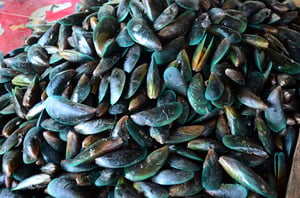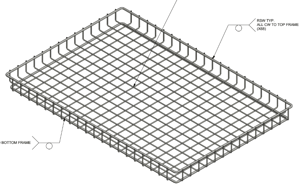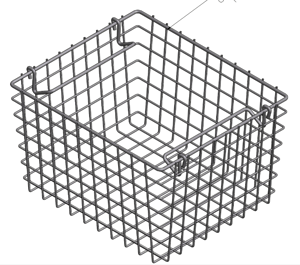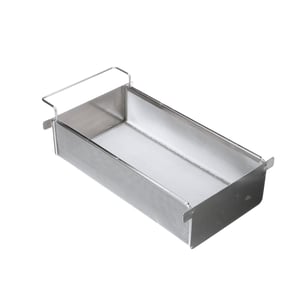 Companies in the seafood industry have numerous challenges to tackle—whether they specialize in the acquisition of seafood or the processing of seafood into a “final” product ready for mass market consumption. Additionally, the nature of these challenges can vary greatly depending on the type of seafood product being harvested/processed and where in the supply chain the company operates.
Companies in the seafood industry have numerous challenges to tackle—whether they specialize in the acquisition of seafood or the processing of seafood into a “final” product ready for mass market consumption. Additionally, the nature of these challenges can vary greatly depending on the type of seafood product being harvested/processed and where in the supply chain the company operates.
Because of the differences in the needs of different seafood companies, each one requires a custom seafood processing basket solution. How do differences between seafood processors affect the design of a custom steel basket?
Here are a few examples of different custom steel baskets that Marlin’s engineering team have designed for various seafood processing applications:
Basket #01485001 Mussel Processing Basket
 This basket was the result of a request from a mussel farm that supplies thousands of tons of mussels to restaurants and seafood distributors around the world. They used a suspended-rope aquaculture process to grow the mussels, but needed a solution for transporting the fully-grown final product through their mussel cleaning/preparation process.
This basket was the result of a request from a mussel farm that supplies thousands of tons of mussels to restaurants and seafood distributors around the world. They used a suspended-rope aquaculture process to grow the mussels, but needed a solution for transporting the fully-grown final product through their mussel cleaning/preparation process.
Because mussels would be pulled straight from the saltwater and placed in the basket, the basket needed to be resistant to corrosion. However, the baskets themselves would not be immersed, so grade 304 stainless steel was determined to be sufficient for the task.
Since the mussels needed to be arranged in a single layer for the client’s processing tasks, the baskets were made to be long and wide (32” L x 22” W), but shallow (2” deep), to maximize the number of mussels that could be processed in each basket. The baskets were made stackable to minimize the floor space needed while the mussels dried off after processing.
Using spot-welded wires provided plenty of open space for optimum airflow while keeping the basket more than strong enough to handle a full load—and the weight of several more fully-loaded baskets stacked on top.
Basket #0205501 Oyster Harvesting Basket
 This basket was designed for use in an oyster farm. Unlike the mussel basket listed above, this basket would be submerged in seawater for prolonged periods of time as a part of the oyster harvesting process. As such, it needed to be made of a material that would be impervious to corrosion and pitting from constant exposure to chlorides.
This basket was designed for use in an oyster farm. Unlike the mussel basket listed above, this basket would be submerged in seawater for prolonged periods of time as a part of the oyster harvesting process. As such, it needed to be made of a material that would be impervious to corrosion and pitting from constant exposure to chlorides.
For this reason, it was deemed necessary to use galvanized steel for this basket. The process of galvanization would give the basket a complete coating of protective zinc that would be relatively easy to remove and reapply as needed. This would maximize the useful life of the basket—reducing the total cost of ownership (TCO) for it over time.
Being a wire basket, water could drain from the basket with ease, allowing the client to dry off their oysters and prepare them for the next stage after pulling the basket from the water.
A pair of adjustable handles would make the basket easy to carry by hand while also serving as footholds for the baskets to stack.
Basket #0204401 Shrimp Peeling Basket
 This basket was designed to work in tandem with a series of shrimp peeling machines. The process involved pre-cleaning the shrimp, feeding the shrimp into the peeler, catching the discarded shells from peeled shrimp and keeping them separate, and rewashing the peeled shrimp to remove the contaminants. An alternative version of the equipment would be used for cooked shrimp and flash-freeze them for shipment.
This basket was designed to work in tandem with a series of shrimp peeling machines. The process involved pre-cleaning the shrimp, feeding the shrimp into the peeler, catching the discarded shells from peeled shrimp and keeping them separate, and rewashing the peeled shrimp to remove the contaminants. An alternative version of the equipment would be used for cooked shrimp and flash-freeze them for shipment.
The baskets would hold the shrimp through the initial phases of the process, feeding the shrimp into the peeler and catching the shells once the shrimp were peeled. An ultra-fine wire mesh would catch even the smallest of discarded shell pieces with ease while still allowing water to flow freely through the basket. This would keep the discarded shells from falling into the equipment, making cleanup easier so sanitation standards could be maintained.
To minimize the risk of food contamination, each seafood processing basket was made out of electropolished grade 304 stainless steel. This gave the stainless steel baskets a microscopically-smooth surface that would prevent bacteria and other byproducts from sticking to the basket—making it easier to sanitize between uses so as to meet strict U.S. Food and Drug Administration (FDA) food sanitation and safety standards.
A large handle on one side of the basket would make it easy to grab for sliding in and out of the processing machinery, while a set of sheet metal plates would help it rest securely in the peeling machine. The grade 304 stainless steel would easily stand up to all of the client’s peeling processes, with their mild aqueous cleaning, cooking, and refrigeration steps all falling well within the tolerances of the material.
Each of the above baskets involved slightly different challenges because of the nature of the processes they were used for, and so the designs for each had to change. If you need help finding the perfect custom seafood processing basket for your own needs, contact Marlin Steel today.
Or, check out our seafood processing baskets guide to learn more about how Marlin Steel meets the challenges of making the perfect processing basket:



.gif)


